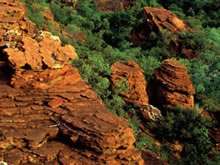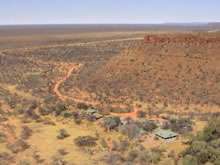Ministry of Environment and Tourism (Waterberg Plateau Park)
- Environmental education
- State reserve
- Tourism
- 405 km2
Towering sandstone cliffs, dinosaur footprints, mysterious rock engravings and some of Namibia’s most rare and valuable game species are synonymous with the Waterberg Plateau Park. Proclaimed in 1972 as a sanctuary for rare and endangered game species, Waterberg has played a vital role in breeding species for the restocking of other parks and conservation areas. The area is also home to the last remaining population of Cape vultures in Namibia.
The park has been zoned into management areas for wilderness, trophy hunting and tourism. The Bernabé de la Bat Rest Camp is one of Namibia’s most visited resorts.
Thousands of surrounding community members receive training at the Okatjikona Environmental Education Centre annually. Situated on the fringe of the park, this is one of Namibia's leading environmental education centres. It hosts school, university and institutional groups and organises learning tours of the Waterberg in conjunction with park staff. It strives to establish environmental education programs that will promote environmental education as a continuous process that occurs in and out of school and considers the environment in its totality, emphasising the compatibility of conservation and sustainable development.
Literature for Ministry of Environment and Tourism (Waterberg Plateau Park)
» See our Literature and other resources section for more general information
-
Leopard population and home range estimates in north-central Namibia
Stein AB, Fuller TK, DeStefano S & Marker LL. 2011. Leopard population and home range estimates in north-central Namibia. African Journal of Ecology, 49: 383–387
» Download -
Opportunistic use of camera traps to assess habitat-specific mammal and bird diversity in northcentral Namibia
Stein AB, Fuller TK & Marker LL. 2008. Opportunistic use of camera traps to assess habitat-specific mammal and bird diversity in northcentral Namibia. Biodiversity and Conservation 17: 3579–3587
During 2006, camera-traps were set within and surrounding WPP to assess leopard density. Fortuitously, photographic results allowed us to assess aspects of mammal and bird diversity and differences among the Park, farms, and the flat lands surrounding the escarpment. Species composition among the three areas was markedly different, and made sense with respect to differences in habitat and management features.» Download -
Ranging behaviour of Cape Vultures Gyps coprotheres from an endangered population in Namibia
Bamford AJ, Diekmann M, Monadjem A & Mendelsohn J. 2007. Ranging behaviour of Cape Vultures Gyps coprotheres from an endangered population in Namibia. Bird Conservation International 17: 331–339
The Cape Vulture is a cliff-nesting vulture endemic to southern Africa. Its range and population size have declined markedly over the last century. Namibia has just one colony, located on the cliffs of the Waterberg Plateau. Five adult males and one immature were captured near the Waterberg site and fitted with satellite-tracking devices and the foraging range was assessed. The ranging behaviour of adult vultures varied throughout the year, and was apparently related to their nesting behaviour.» Download -
The feeding ecology of Ruppell’s Parrot Poicephalus rueppellii in the Waterberg, Namibia
Selman RG, Perrin MR & Hunter ML. 2002. The feeding ecology of Ruppell’s Parrot Poicephalus rueppellii in the Waterberg, Namibia. Ostrich 73:(3&4): 127-134
-
Waterberg Camp fact sheet
Waterberg Camp fact sheet
Fact sheet describing the location, accommodation, services and activities available at Waterberg Camp.» Download





